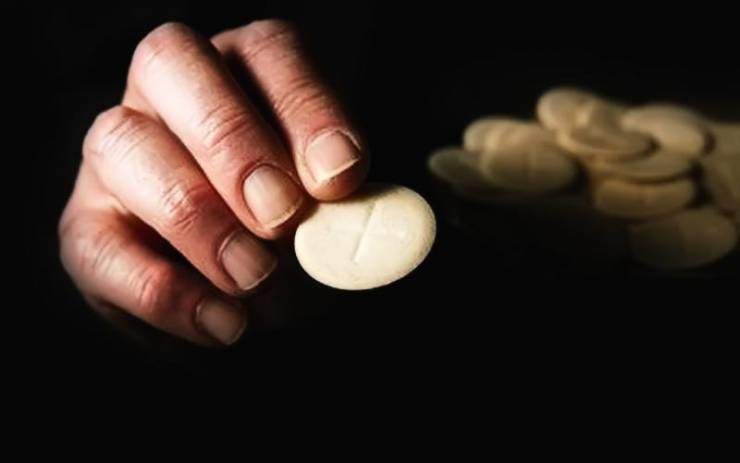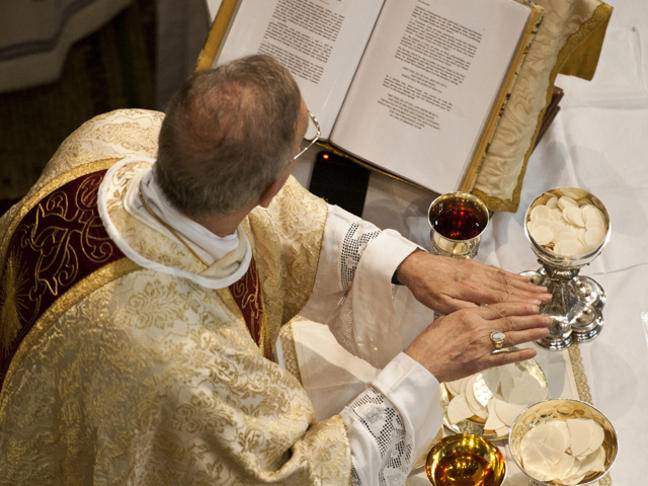Many people were perplexed when bishops would not allow the substitution of a grain flour other than wheat. Instead, the Church recommended that those with celiac disease receive Communion under the form of sacramental wine. To many, this seemed arbitrary, inflexible, and even cruel. It seemed an unjust discrimination to exclude them from partaking of the consecrated host shared by the majority of communicants. What difference should it make, they complained, which flour is used for altar bread? Would Jesus really care if the bread to be consecrated were made of a non-glutinous grain (such as rice)?
The Congregation for the Doctrine of the Faith ruled on this in 2003:
- Hosts that are completely gluten-free are invalid matter for the celebration of the Eucharist.
- Low-gluten hosts (partially gluten-free) are valid matter, provided they contain a sufficient amount of gluten to obtain the confection of bread without the addition of foreign materials and without the use of procedures that would alter the nature of bread.
Dr. David P. Lang writes a clarification, Why Wheat Bread?, in Catholic Answers Magazine that is most helpful.
Recently, a particularly thorny pastoral difficulty arose over the use of wheat flour for Communion hosts. The issue was celiac disease—a severe condition of gluten intolerance in which the consumption of any grain having a certain protein (alpha-gliadin) provokes an allergic reaction resulting in serious intestinal damage.
Many people were perplexed when bishops would not allow the substitution of a grain flour other than wheat. Instead, the Church recommended that those with celiac disease receive Communion under the form of sacramental wine. To many, this seemed arbitrary, inflexible, and even cruel. It seemed an unjust discrimination to exclude them from partaking of the consecrated host shared by the majority of communicants. What difference should it make, they complained, which flour is used for altar bread? Would Jesus really care if the bread to be consecrated were made of a non-glutinous grain (such as rice)?
Let’s begin to answer that question by recalling that all the sacraments employ material things as channels of grace, actually bringing about the spiritual effects that they symbolize. Now it’s obvious that some materials are more conducive than others for serving a specific symbolic function. This fact does not render other materials inferior in intrinsic dignity—merely less fitting in their representative value for a given purpose.
For example, when our Lord instituted baptism, the sacrament of spiritual rebirth, he explicitly mandated water (see Jn 3:5). Indeed, only water is an appropriate physical substance for baptism, because more than any other liquid it is apt for signifying what it produces in the soul: cleansing from sin and regeneration into the new life of sanctifying grace.
So, then, the key question remains to be answered. Why, among all grains, is wheat the most suitable for the Blessed Sacrament, wherein Christ is truly present under the appearances of bread? (See Mt 26:26; Mk 14:22; Lk 22:19; 1 Cor 11:23-24; also CCC 1375-1377.)
First, wheat is associated with being sown, fallen, crushed, and buried, but then springing up for bread to feed multitudes. These are all symbols of Christ’s passion, death, resurrection, and communion with his Church in the Sacrifice of the Mass. Moreover, wheat, standing in a field under the sunlight, shimmers like gleaming gold. We notice that the sacred vessels in which consecrated hosts repose (namely, the ciborium and monstrance) are constructed from gold, a costly metal that has become affiliated with the Blessed Sacrament.
Nevertheless, someone may protest that other grains have the same natural connotations. It would seem to follow that they could be valid matter for eucharistic confection—at least when some need arises for an exception from the Church’s standard practice and disciplinary policy.
The truth is, this Catholic doctrine cannot be demonstrated solely by unaided human reason. It can, however, be vindicated rationally on the basis of Scripture. Thus, any Christian who accepts the Bible as the inspired word of God should be able to grasp the deep reasons justifying the Catholic position.
An Image of Christ . . .
We know that Jesus calls himself the “bread of life” (Jn 6:35, 48, 51). Furthermore, we recall that in John 12:24 (NAB), during Passion week, he likens his own body to wheat, when he declares: “I solemnly assure you, unless the grain of wheat falls to the earth and dies, it remains just a grain of wheat. But if it dies, it produces much fruit.” Here we observe those symbols of sowing, falling, burying, and rising applied by Christ to himself, who therefore becomes the “wheat bread of life” (see 1 Cor 15:20, 36-37, where Paul suggests something similar).
. . . His Apostles and Their Successors . . .
Next, during the course of the Last Supper, Jesus compares Peter (and, by extension, the other apostles) with wheat in Luke 22:31-32 (NAB), when our Lord admonishes him: “Simon, Simon! Remember that Satan has asked for you to sift you all like wheat. But I have prayed for you that your faith may never fail. You in turn must strengthen your brothers.” These critical verses imply a participation of the bishops and priests (successors and delegates of the apostles) in our Lord’s salvific mission. They, too, must undergo a bruising process of refinement, akin to threshing wheat, which ultimately leads to bread for fortifying others. In other words, they are alter Christi destined to nourish the Church with the fruits of their own self-sacrificing toil (see also Gn 3:19). If Christ is metaphorically the “wheat bread of life,” then so are his Church’s ministers.
. . . The Laity . . .
In fact, even the faithful lay members of his Church are implicitly equated with wheat in the parable of the wheat and the weeds. See Matthew 13:24-30, which ends with the command: “gather the wheat into my barn.” Note that Psalm 1:4 calls the wicked “chaff”—the empty hulls sloughed off during grain-threshing. Now chaff is literally “detritus”—a term that, even if not etymologically related to the Latin for “wheat” (triticum) could surely be a wordplay on the latter. At any rate, the chaff is what has literally been “de-wheated.” St. John the Baptist furnished a preview of Christ’s analogy between the elect and wheat—as opposed to the reprobate and debris—when he proclaimed to the crowds the coming of one who would “clear his threshing floor and gather the wheat into his barn” but burn the “chaff” (Mt 3:12 and Lk 3:17; cf. Mal 3:3).
. . . and the Universal Church
Finally, in Mark 4:26-28, Jesus compares the growth of the Church’s entire body (under his headship, according to Ephesians 1:22-23; 5:23) to the development of ripe “grain” through stages. The New American Bible translates the Revised Standard Version’s “grain” as “wheat,” a more specific term that is actually the primary rendering of the Greek sitos (see 1 Cor 15:37). Since the Eucharist is the sacrament of unity, containing essentially all of the Universal Church’s goods (the principal good being her Head), the substitution of non-wheaten flour for altar bread seems inconceivable based on the above citations from the Gospels of John, Luke, Matthew, and Mark.
Paul: “I Imitate Christ”
Yet, beyond these rather obvious texts, a more subtle interweaving of themes appears elsewhere. First, in Matthew 26:26, Mark 14:22, Luke 22:19, and 1 Corinthians 11:23-24, we witness the same Paschal event. Jesus takes bread, blesses it, and breaks it, while pronouncing the sacred words of eucharistic institution: “Take and eat. This is my body [which is given up for you].” Second, in Luke 24:30-31, 35, we view the poignant scene of the disciples on the road to Emmaus, who came to recognize the risen Lord only “in the breaking of bread.” Third, in Acts 2:42, we learn that the members of the early Christian community “devoted themselves . . . to the breaking of bread and the prayers.” Fourth, in 1 Corinthians 10:16 (NAB), Paul asks rhetorically: “Is not the bread we break a sharing in the body of Christ?” The last two verses quoted undoubtedly refer to the continual re-enactment of the Last Supper in the Mass, as Christ had commanded.
Of course, all these verses are well-known to the point of humdrum familiarity. They appear to furnish no justification for wheat as altar bread, as opposed to some other grain (say, barley or rice). But what seems to have passed unnoticed is Acts 27:35-38. Here Luke records that Paul “took some bread, gave thanks to God before all of them, broke it, and began to eat” (NAB). And then comes the clincher. It turns out, according to the last verse of this passage, that the bread Paul used was wheat!
Now Paul handed on what he received directly from the Lord (see 1 Cor 11:23). Indeed, he declared in 1 Corinthians 11:1 that “I imitate Christ” (NAB). Thus, he would not have deviated from Christ’s own conduct in this matter during the Last Supper. We must assume that the apostle was simply following his Master’s prescriptions, including the fundamental material ingredients of the Mass. Even if what transpired on board the ship in this passage from Acts 27 was not technically a Mass, from the very verbal formulation of the verses, the meal clearly bears resemblance to a eucharistic celebration. Hence, its symbolic connotations, revolving around the motif of “breaking bread,” strongly suggest that the bread at the Last Supper was wheaten.
The Passover Probability
An auxiliary argument requires consulting the Old Testament. Since the Last Supper was a Passover celebration, it is logical that Christ would have used the same kind of unleavened bread as Moses at the original Passover meal. Some might think that it must have been barley, on the grounds that Christ multiplied barley loaves in John 6 prior to the Bread of Life discourse—a miraculous provision of bread that indeed foreshadowed the conversion of bread into his body on Holy Thursday. Read, however, Exodus 9:22-32; 10:4-6, 12-15. These passages report that the hailstone plague on Egypt destroyed all growing barley grain, while implying that the subsequent locust plague depleted all the barley flour in storage bins. But, according to 9:32, “the wheat and the spelt were not ruined, for they grow later.” Although the portion of land where the Israelites dwelled was spared these curses (9:26), by the time of the last plague, when the departure of the Israelites from Egypt was imminent, an overall scarcity of barley to make bread for the Passover meal would probably have prevailed. The only alternatives were wheat and spelt. Given our previously cited texts, none of which even mention spelt, we deduce by process of elimination that Jesus employed wheat bread at the Last Supper.
Since the Last Supper was the first Mass, which cannot be changed in its essentials, we conclude from this reasoning (along with the earlier texts) that no bread other than wheaten can be valid matter for transubstantiation.
Wheat of Life
Also in the Old Testament, we find that the Song of Songs 7:3 (NAB) prophesies about the bride (who prefigures both the Blessed Virgin and the Church), “Your body is a heap of wheat encircled with lilies.” The Revised Standard Version translates the corresponding Song of Solomon 7:2b as: “Your belly is a heap of wheat, encircled with lilies.” In either rendition, this verse is highly significant, because Mary bore the divine Messiah in her womb, making the pure woman who is “full of grace” (Lk 1:28; cf. Gn 3:15) the Mother who is full of “wheat.” Moreover, the Savior is continually re-presented to the world from the sacred precincts (“belly”) of the Church at the core of every Mass, so that the “body” of the Church (“without blemish” according to Ephesians 5:25-27; Revelation 21:2, 10-11) is also at its center full of “wheat.” Consequently, Jesus, the “Bread of Life” (Jn 6:35, 48, 51) is, more specifically and irrevocably, the “Wheat of Life.”
But we need not rest our whole case here. We can find additional support in other Old Testament events and prophecies, which prefigure the identification of Christ’s body with wheat.
First, for use in the priestly ordination rite of Aaron and his sons, God commanded Moses to make “unleavened cakes and wafers” out of “fine wheat flour” (Ex 29:2). The context of this embedded verse is replete with typological foreshadowings of the Mass: The flour, blood, and wine prefigure the sacrifice of Jesus throughout Exodus 29, whereas the olive oil (mixed with fine flour) here and in both Leviticus 2 and Numbers 28:5 symbolizes the action of the Holy Spirit, who at the epiklesis is invoked to come down upon the altar bread, changing it into the body of Christ.
Next, Isaiah 55:10-11 supplies an analogy between the role of heavenly rain descending to water the ground (rendering it fertile for seed and eventually bread) and the “word” sent from God to accomplish his divine mission. Indeed, we know from John 1:1 and Revelation 6:9; 19:13 that the “Word” proceeding from God the Father is our Redeemer, the Lord Jesus. Christ, the Word of God and the Just One who dropped like dew from heaven on a sinful world barren as a desert, is the Father’s productive seed who provides us our spiritual bread—his very own flesh (according to John 6:32-35, 48-58).
Christ, the Finest Wheat
How does all this pertain to wheat? A key link in this chain of reasoning is Jeremiah 23:28-29. These remarkably revealing verses, which depict God’s word as “fire” and “a hammer shattering rocks,” also compare the divine word with “wheat.” We are reminded of John the Baptist’s heralding of the Messiah who would “baptize in the Holy Spirit and fire,” wielding a “winnowing-fan in his hand to clear his threshing floor and gather the wheat into his barn” (Lk 3:17, NAB).
Christ is the sower of supernatural seed. He is the Eternal Word spreading the evangelical word of truth in the parable recorded in Matthew 13:1-23. Because this passage occurs immediately before the parable of the wheat and the weeds (Mt 13:24-30), we infer that the seed sown is wheat. But some of these grains of wheat are trampled underfoot, pecked by birds, crushed, and choked with thorns—perhaps a layer of veiled prophecies regarding the compassionate suffering of Christ and the saints when the word of truth is rejected and the Bread of Life is scorned (see Jn 15:20; Lk 10:16).
Taking our cue from the overarching text of Jeremiah 23, we might hear our Lord once again comparing his body (and the faithful united with him) to wheat, since both he and his servants are the grains of crushed wheat baked into bread that rises for the sake of bringing salvation to mankind. Although we recognize the disfigured face of Jesus wherever there is persecution, on the other hand we behold the glorious countenance of the wheaten Word when charity prevails—that is, when bread is broken and distributed through the spiritual and corporal works of mercy (see Is 21:14; 58:6-8 and Mt 25:34-40).
Observe that Psalm 81:16 (RSV)/17 (NAB) proclaims God’s eucharistic promise for the Church (the New Israel): “I would feed you [Israel] with the finest of the wheat.” Psalm 147:14 (NAB) then announces the fulfillment of this divine pledge: “With the best of wheat he fills you.” (The RSV reads: “the finest of the wheat”; cf. Rv 18:13.) In these two verses, the “finest” or “best” is God’s beloved and only begotten Son, clearly identified with wheat.
An Offering Precious as Gold
We have space merely to summarize two Old Testament episodes connecting the Wheat Bread of Life with the theme of gold.
First, 1 Chronicles 21:18-28 recounts a fascinating transaction between King David and Ornan the Jebusite (an inhabitant of Jerusalem), who graciously offered to give David his threshing floor, some wood, and some wheat for a cereal holocaust of sin-atonement. David, however, refused the free gift and insisted on paying Ornan a large sum of gold. The remarkable thing is that this burnt sacrifice occurred at an altar on Mount Moriah, which Abraham had climbed to offer up his son Isaac (a type of Christ) on a pile of wood, on the very site where Solomon’s original temple was later built. It was near this spot in Jerusalem where God the Father offered up his Son (also called in the Gospels the “Son of David”) on the wood of the cross in atonement for the offenses of mankind. The upshot is that the threshed wheat symbolizes the crushed body of Christ valued as precious gold, which throughout the centuries has been used to manufacture the vessels for the Blessed Sacrament.
Second, 1 Samuel 6:1-15 narrates the story of the return on a wagon of the gilded ark of the covenant, laden with manna and accompanied by a box of golden guilt-offerings, to Israel at Bethshemesh (“House of Light” or “House of the Sun”), where the people, now rejoicing to see the arrival of the ark, “were reaping their wheat harvest in the valley.” In this instance, the milch cows pulling the cart were sacrificed on its wood, while the golden tokens were set upon a large rock.
This passage couches some extraordinarily deep typology revolving around Jesus (the “light of the world” in John 8:12; 9:5 and the “sun of righteousness” in Malachi 4:2, RSV), Mary (whom the Litany of Loreto calls “House of Gold” and “Ark of the Covenant,” noting Revelation 11:19; 12:1), the Visitation to St. Elizabeth, the manna of the Holy Eucharist given by Christ (the New Moses)—and golden wheat (see my book Why Matter Matters for further elucidation).
It Does Make a Difference
Consequently, based on an overwhelming abundance of scriptural sources (and there are more that space precludes discussing), it is impossible that the Church could define any grain other than wheat as valid matter for the consecration at Mass: Transubstantiation of bread into the body of Christ can occur using only unadulterated wheat flour (see CCC 1412 and CIC 924). There is no biblical support for any other grain: Even barley rates a distant second place—never mind spelt, millet, flax, or rice, the last not once mentioned. Indeed, the sacramental symbolism of wheat dominates, to the exclusion of all other grains, Christ’s parabolic metaphors about himself, his apostolic hierarchy, his elect, and the very history of his kingdom on earth. It is no exaggeration to say, according to Christ’s own assertions, that the entire Church, both Head and members, should be regarded as one tightly unified mass of wheat. Thus, the “one bread, one body” (alluded to in 1 Cor 10:16-17; 12:12-13 and Eph 4:4) undoubtedly means that the universal body of Christ must be considered one loaf of wheat bread.
Bound Together in Christ
So, what should be done about the sad situation of those afflicted with celiac disease? Fortunately, there is now available Church-approved low-gluten wheat bread, even a small morsel of which would suffice for receiving Jesus, who is wholly present (“body, blood, soul, and divinity”) in every tangible piece of a consecrated host. The rare individuals who may undergo an allergic reaction to even the tiniest fragment of low-gluten altar bread can still receive the entire Christ by consuming merely several drops of his precious blood under the form of consecrated grape wine.
Nevertheless, valid altar bread must contain some gluten. Ironically, it is the presence of this potentially allergenic viscous substance that makes wheat flour (more than any other kind of grain) possess by nature a very cohesive consistency. It is thereby able to play, to a superlative degree, the sacramental role of representing the unity of the Church (the body of Christ) in communion with her Head. As Paul states in Colossians 1:17 (RSV), “in [Christ] all things hold together”—just as in wheat flour batter the whole mixture sticks together by virtue of the gluey protein. Note also Psalm 122:3, where Jerusalem, mystically interpreted as the Church, is viewed as “bound firmly together” (RSV) “with compact unity” (NAB).
Good has already come from this distressing controversy. As often happens in the wake of heresy, we now have a firmer grasp of the stakes involved. We understand why the Church cannot make exceptions concerning what may have seemed (superficially at the outset) a minor matter susceptible to compromise. And maybe we can begin to grasp that God exacts such high standards for the enactment of sacramental rites lest his children fall into the Gnostic error of thinking that matter doesn’t really matter.
SIDEBARS
Gnosticism at the Heart of the Problem
At the root of many contemporary cultural battles lies a conflict over the relevance of matter and material distinctions. A worldview labeled “Gnostic”—erupting periodically throughout history—has disdainfully sought to exalt human consciousness and will at the expense of lowly corporeal things. In our own era, through contemporary scientific advances, an influential utilitarian ideology has acquired the power to manipulate generative forces so consummately that the human embryo is considered either a consumer commodity fabricated for parental owners or else expendable fetal tissue disposable for any supposedly noble purpose (such as harvesting organs or stem cells).
Gnostic indifferentism toward matter has, not surprisingly, likewise invaded the arena of the seven sacraments. Feminist sympathizers deny that gender bears any relevance for priestly ordination, while adherents of the militant homosexual agenda agitate for civic recognition of same-sex “marriage.” At stake is whether human beings enjoy the prerogative to determine what materials are the proper subjects for sacramental rites.
A Little Is Enough
In the “Norms for Use of Low-Gluten Bread and Mustum ” (August 22, 1994) the Congregation for the Doctrine of the Faith declared that gluten-free hosts are “invalid matter for the celebration of the Eucharist”; however, “low-gluten hosts are valid matter, provided that they contain the amount of gluten sufficient to obtain the confection of bread, that there is no addition of foreign materials and that the procedure for making such hosts is not such as to alter the nature of the substance of the bread.”
Further Reading
- Instruction Concerning Worship of the Eucharistic Mystery (Inaestimabile Donum) by the Congregation for Divine Worship and the Discipline of the Sacraments (available at www.adoremus.org)
- Scandal of the Incarnation: Irenaeus against the Heresies, ed. Hans Urs von Balthasar (Ignatius)
- Why Matter Matters: Philosophical and Scriptural Reflections on the Sacraments by David Lang (Our Sunday Visitor)
David P. Lang has a Ph.D. in philosophy from Boston College and a Ph.D. in mathematics from Northeastern University. His articles have appeared in Homiletic and Pastoral Review, Faith and Reason, and This Rock.




